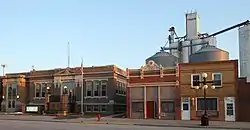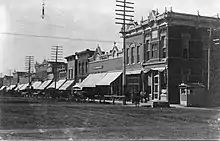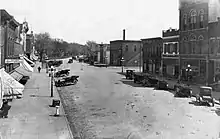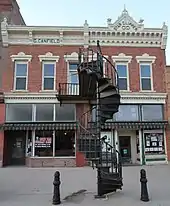Traer, Iowa | |
|---|---|
 Downtown buildings including the Carnegie library and grain elevator | |
 Location of Traer, Iowa | |
| Coordinates: 42°11′29″N 92°27′52″W / 42.19139°N 92.46444°W | |
| Country | |
| State | |
| County | Tama |
| Government | |
| • Mayor | Pete Holden |
| Area | |
| • Total | 1.29 sq mi (3.34 km2) |
| • Land | 1.29 sq mi (3.34 km2) |
| • Water | 0.00 sq mi (0.00 km2) |
| Elevation | 915 ft (279 m) |
| Population (2020) | |
| • Total | 1,583 |
| • Density | 1,228.08/sq mi (474.02/km2) |
| Time zone | UTC-6 (Central (CST)) |
| • Summer (DST) | UTC-5 (CDT) |
| ZIP code | 50675 |
| Area code | 319 |
| FIPS code | 19-78735 |
| GNIS feature ID | 0462294 |
Traer is a city in Tama County, Iowa, United States. The population was 1,583 at the time of the 2020 census.[2]
Traer is known for the iron spiral staircase that originally led to the office of the local newspaper. The staircase is freestanding, reverse-spiral and connected to the building with a suspended walkway, a somewhat rare arrangement.
History


Traer got its start in the year 1873, following construction of Burlington, Cedar Rapids and Northern Railway through the territory.[3] The city was named for John W. Traer.[4]
Geography
Traer is located in Perry Township.
According to the United States Census Bureau, the city has a total area of 1.18 square miles (3.06 km2), all land.[5]
Important roads in Traer include U.S. Route 63 and Iowa Highway 8.
Demographics
| Year | Pop. | ±% |
|---|---|---|
| 1880 | 1,100 | — |
| 1890 | 1,014 | −7.8% |
| 1900 | 1,458 | +43.8% |
| 1910 | 1,283 | −12.0% |
| 1920 | 1,329 | +3.6% |
| 1930 | 1,417 | +6.6% |
| 1940 | 1,493 | +5.4% |
| 1950 | 1,627 | +9.0% |
| 1960 | 1,623 | −0.2% |
| 1970 | 1,682 | +3.6% |
| 1980 | 1,703 | +1.2% |
| 1990 | 1,552 | −8.9% |
| 2000 | 1,594 | +2.7% |
| 2010 | 1,703 | +6.8% |
| 2020 | 1,583 | −7.0% |
| Source:"U.S. Census website". United States Census Bureau. Retrieved March 29, 2020. and Iowa Data Center Source: | ||

2010 census
As of the census[7] of 2010, there were 1,703 people, 693 households, and 458 families living in the city. The population density was 1,443.2 inhabitants per square mile (557.2/km2). There were 778 housing units at an average density of 659.3 per square mile (254.6/km2). The racial makeup of the city was 98.0% White, 0.2% African American, 0.2% Native American, 0.4% Asian, 0.1% Pacific Islander, 0.1% from other races, and 1.1% from two or more races. Hispanic or Latino of any race were 0.8% of the population.
There were 693 households, of which 30.2% had children under the age of 18 living with them, 52.8% were married couples living together, 9.7% had a female householder with no husband present, 3.6% had a male householder with no wife present, and 33.9% were non-families. 30.0% of all households were made up of individuals, and 18.9% had someone living alone who was 65 years of age or older. The average household size was 2.35 and the average family size was 2.91.
The median age in the city was 43.5 years. 23.7% of residents were under the age of 18; 6.2% were between the ages of 18 and 24; 22.6% were from 25 to 44; 22.2% were from 45 to 64; and 25.1% were 65 years of age or older. The gender makeup of the city was 47.6% male and 52.4% female.
2000 census
As of the census[8] of 2000, there were 1,594 people, 686 households, and 443 families living in the city. The population density was 1,446.4 inhabitants per square mile (558.5/km2). There were 728 housing units at an average density of 660.6 per square mile (255.1/km2). The racial makeup of the city was 99.31% White, 0.31% African American, 0.13% Asian, and 0.25% from two or more races. Hispanic or Latino of any race were 0.13% of the population.
There were 686 households, out of which 25.2% had children under the age of 18 living with them, 55.5% were married couples living together, 6.0% had a female householder with no husband present, and 35.3% were non-families. 31.0% of all households were made up of individuals, and 20.1% had someone living alone who was 65 years of age or older. The average household size was 2.21 and the average family size was 2.75.
20.9% were under the age of 18, 6.1% from 18 to 24, 23.1% from 25 to 44, 21.7% from 45 to 64, and 28.2% were 65 years of age or older. The median age was 45 years. For every 100 females, there were 86.4 males. For every 100 females age 18 and over, there were 81.4 males.
The median income for a household in the city was $35,329, and the median income for a family was $43,375. Males had a median income of $30,882 versus $20,670 for females. The per capita income for the city was $17,811. About 4.9% of families and 7.0% of the population were below the poverty line, including 7.6% of those under age 18 and 8.0% of those age 65 or over.
Government
The city is governed by a mayor-council government, with a five-member council. It employs an attorney, a treasurer, a clerk and deputy clerk, and a gas and building inspector. The city runs multiple committees, on finance, streets, airport and garbage, recreation, public services, and protection. City boards include those responsible for the library, the airport, the parks, the memorial building, planning and zoning, the Wilson Nature Preserve, and historic preservation.
Education
Traer is within the North Tama County Community School District.[9]
Infrastructure
Services provided by the city include a fire department, an ambulance service, a swimming pool, a public library, an airport, and two parks.
Notable people
- James "Tama Jim" Wilson lived in Traer after serving as U.S. Secretary of Agriculture and was buried in a cemetery northwest of the town in 1920.
- Margaret Wilson, who won the Pulitzer Prize for fiction in 1924, was born in Traer.
References
- ↑ "2020 U.S. Gazetteer Files". United States Census Bureau. Retrieved March 16, 2022.
- 1 2 "2020 Census State Redistricting Data". census.gov. United states Census Bureau. Retrieved August 12, 2021.
- ↑ Chapman, Samuel D. (1879). History of Tama County, Iowa: Its Cities, Towns and Villages. Toledo Times Office. pp. 253.
- ↑ Chicago and North Western Railway Company (1908). A History of the Origin of the Place Names Connected with the Chicago & North Western and Chicago, St. Paul, Minneapolis & Omaha Railways. p. 131.
- ↑ "US Gazetteer files 2010". United States Census Bureau. Archived from the original on January 25, 2012. Retrieved May 11, 2012.
- ↑ "Census of Population and Housing". Census.gov. Retrieved June 4, 2015.
- ↑ "U.S. Census website". United States Census Bureau. Retrieved May 11, 2012.
- ↑ "U.S. Census website". United States Census Bureau. Retrieved January 31, 2008.
- ↑ "North Tama County" (PDF). Iowa Department of Education. Retrieved March 28, 2020.